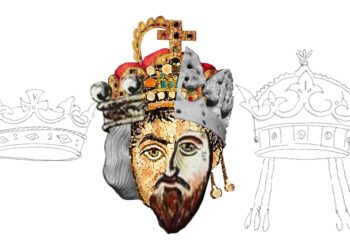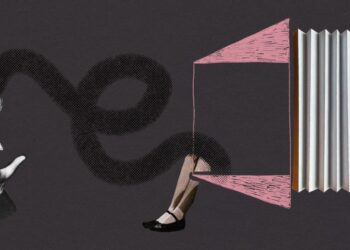

In the village of Verishen in Armenia’s southern Syunik region, the opening of an exhibition took place on June 3, 2023, under the aegis of the AHA collective called “Living Portals: Settlement Fabrics of Khndzoresk, Tegh and Verishen”. Curated by Nairi Khatchadourian, the exhibition is stationed in two locations – a formerly vacant Soviet-era House of Culture and the neighboring desolate Church of St. Hripsime (4th–17th century). In doing so, the exhibition metaphorically weaved together and, at least for the time-being, rejuvenated these neglected material remnants of very different historical time periods. What started with the “Bold Khndzoresk” contemporary carpet designs by artist Davit Kochunts, has expanded over the project’s development to include graphic works, ceramics, photography, archival and architectural research. Passing through the improvised exhibition halls, where every object is deeply and tangibly rooted in the locality, enables a visceral and embodied sensation of being in a place in harmony with the moment. At the same time, it inspires (re)thinking of abstract analytical categories that connect being with knowing.
The idea for this text was conceived as somewhat of a reflection on Living Portals in a very broad sense. Drawing inspiration from Khatchadourian’s essay “Carpet as Territory” published in the exhibition’s catalog, I attempt to facilitate a discussion about the social space and the process of territorialization in Armenia.[1] This discussion is a work-in-progress, adhering with Virginia Woolf’s statement that “Lies will flow from my lips, but there may perhaps be some truth mixed up with them; it is for you to seek out this truth and to decide whether any part of this is worth keeping.” In the spirit of Living Portals, the carpet in my text is the origin of the chain of thought and its cornerstone.
Core Spatial Categories and Their Differentiation
“With its in-situ placement, the carpet also becomes a territory itself; it marks a space, a spatial counter, distinct from its surroundings.”[2] This sentence, remarkably poetic, brings forward and binds three core categories in spatial studies – space, place and territory. The three exist simultaneously whenever we experience spatial phenomena in different contexts, scales and historical periods. Thus, they seem polysemic and polemic. However, space, place and territory are imbued with characteristics that differentiate them from one another.
As an analytical category, space precedes any other spatial concept. According to the French Marxist philosopher Henri Lefevbre, who wrote perhaps the most influential work about space in social sciences “The Production of Space”, space is neither a thing nor a container. It is a relational and dynamic product that is being (re)produced constantly through various human interactions. Being ultimately social, space exists as a triad: conceived, perceived and lived. In order to explain it, I draw on the example of St. Hripsime Church in Verishen. As a conceived space, it was measured and created by local stonemasons. As a perceived space, it was organized through the daily routines and activities of worship. As a lived space, the church is shaped by subjective experiences of the visitor, their personal emotions and memories. These perceptions will unquestionably differ between individuals who use it regularly as a space of worship and those whose purpose was a one-time visit to the Living Portals exhibition.
Discussions about place and territory begin by stating that they are a portion of a bounded space. Yet, according to Fabio Duarte, “While place is defined by effective values, territory tends to be demarcated through imposed values; while place is chiseled by subjective values, territory tends to reign over those who occupy it.” A territory, thereby, is linked to the issues of belonging and control. Whose territory? For instance, questioning whether a church can be re-made into an exhibition hall is a question of territorialization, which is related to the way human activity is organized and fixed in space under political and social forces.
Home–ing as a Form of Territorialization
Territory and territorialization are quintessential to the State. Defining territories, just like writing history, has long been done in the name of a unitary state apparatus, as noted by Deleuze and Guattari. States lay claims over spheres of influence, forcing privileges and drawing boundaries in space. But what do territory and territorialization mean for a nation, such as the Armenians, that have a long history of being stateless? A nation that has experienced violent displacements and semi-voluntary relocations. Perhaps, at least partially, the answer to this question lies in the domain of the private, the domain of home of which the carpet is representative both materially and symbolically.
Carpets were among the objects taken by Armenians from their homes as they fled the 1915–1921 Genocide. On the road, they were used to create tents that provided shelter and refuge. In other words, the carpet’s soft and warm materiality was used to quite literally build a home and demarcate a safe territory. This practice resembles the traditional Armenian rituals linked to the major transformative ceremonies around birth, weddings, and death where the carpet was a central element drawing a boundary that the evil of the outside world could not cross. It lined the walls of a child’s sleeping place, was placed as a centerpiece for weddings and given as a major part of the dowry, and was used to cover up the corpse of the deceased. Davit Kochunts’ carpet designs also speak to this tradition. Created from the memory of his hometown, they depict the caves of Khndzoresk as portals towards homes and shelters during armed conflicts.
In the course of my ongoing anthropological research in one of Armenia’s small towns, I’ve noticed how carpets imbued with sacred and intimate symbolism “spill out” from the seemingly private to the seemingly public spatial domains. In the mornings, my female neighbors sweep the floor in the yard of our Stalin-era apartment building, they wash the table in the gazebo, and unroll carpets in the passages and on the benches. The extension of the carpet’s presence from the immediate home to the yard hints to the fluid divide between public and private spaces, or rather territories in contemporary Armenia. The line between them is drawn not through the legal status, but rather through emplacement of home symbolism and the practices of care.
As noted by the anthropologist Lori Khatchadourian, after the collapse of state socialism the local notion of ownerlessness – anter [անտեր] – in Armenian is used to talk about neglected localities, rather than those that de jure have no owner. The formula for dealing with the post-Soviet disorder produced by the combination of “shock therapy”, (neo)liberalization, hectic privatization, and military conflicts is gendered. While men do repair, women do provide the care. Through collective care work over space, women in Armenia become symbolic owners and border guards of territories across scales. In their hands, the unfolding carpet becomes a way of home–ing space and a means of territorialization occurring away from or below the State’s gaze.
Delineating Territory and (re)Animating a Place
A part of the Goris municipality, Verishen village is located in a complex geopolitical context of a border zone with a warring neighbor. While military clashes remain in the spotlight of media and policymaking, the war between Armenia and Azerbaijan has also been fought through claims to cultural heritage. One of which is the claim over the carpet as a representative element of national culture, as well as through its design and process of creation as a geographical marker of territory. The contemporary carpet collection exhibited within the Living Portals designed by Davit Kochunts as an allegory of the cave dwellings of Khndzoresk and woven by the women working at the Verishen Crafts Center leaves no doubt of the carpets’ origin. In this sense, exhibiting these powerful territorial symbols deeply rooted in the Goris surroundings is a clear political statement by the artist and the AHA collective. It stakes out the territory of home, safety, and freedom through artistic practice in which Armenian women — the weavers, majority of the exhibited artists, and the curator — yet again serve as active agents of territorialization.
Using art as a means for regenerating places has become a common strategy worldwide. At the same time, many such projects remain imposed top-down, leaving little positive impact on the everyday life of local inhabitants. On the contrary, as demonstrated by a number of similar projects undertaken in Armenia previously, such initiatives can either lead to further disenchantment, spatial commodification, gentrification, or simply serve as fodder for the centralized circuits of creative economy. Living Portals can definitely be viewed as an attempt to regenerate two desolate and neglected premises, which perhaps has an even higher aim to (re)animate the village of Verishen itself. But in its nature, the project is neither alien nor alienating. Rather, through the deep, engaging, and empowering collaboration with the place and the community, AHA collective has attempted to “cohabit and weave together the scattered fragments of reality.” The ground has been cleared and the carpet unfolded; how the relationships between the inhabitants and the exhibition participants, as well as between people and their territory in Verishen will be re-shaped and evolve further, only time can tell.
Footnotes:
[1] Khatchadourian, N. ed. (2023). “Living Portals: Settlement Fabrics of Khndzoresk, Tegh, and Verishen”. Yerevan: Antenor Printing House.
[2] Իր տեղհատուկ տեղադրումով գորգն ինքնին տարածք է, իրեն շրջապատող առարկաներից անշատ տարածական մի միավոր: In Armenian, տարածք can mean both space and territory. Thereby, the distinction between the two analytical categories that exist in English might make less sense in Armenian.
Et Cetera
Don Quixote: Present and Absent in Armenian
The Armenian translation of Cervantes’“Don Quixote” has not yet reached readers, despite being a masterpiece of world literature. Aram Pachyan delves into the reason behind this.
Read moreA Vision of Power: The Royal Crowns of Cilicia
Crowns worn by monarchs reveal stories of hierarchy and power, providing insight not only to those who wore them, but the strata to which they belonged. Margarita Ghazaryan looks at the story of the royal crowns of the Armenian Kingdom of Cilicia.
Read moreArt as a Tool for Conflict Transformation and Healing War Trauma
Art can be an effective tool of conflict transformation impacting societal attitudes and perceptions by producing a cathartic effect on both artists and audiences, writes Anna Kamay.
Read moreLove and [un]Love in “The Miracle Worker”
Nune Hakhverdyan reviews the Armenian production of “The Miracle Worker” staged by the Gyumri Drama Theater and Yerevan’s Hamazkayin Theater about the life of Helen Keller, and examines the relationship between parent and child.
Read morePower Is (the) Truth
During March 2022, the Word—not only allegorically, but in the most literal sense—finds itself outstretched like the Vitruvian man strung from the corners of our Armenian-Russian-Ukrainian semiotic triangle.
Read more





